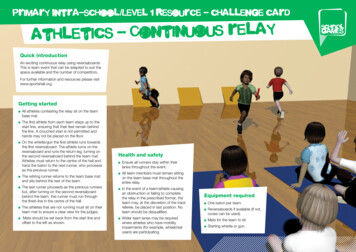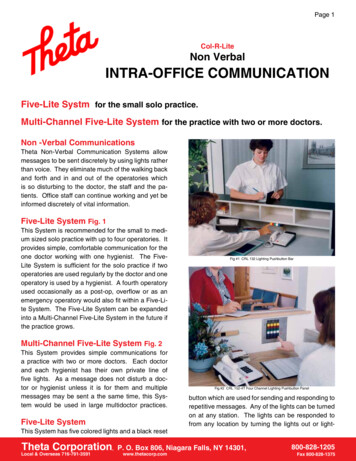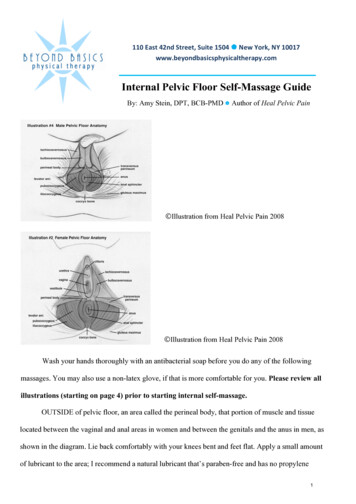
Transcription
primary Intra-school/Level 1 Resource - challenge cardathletics - Continuous relayQuick introductionAn exciting continuous relay using reversaboards.This is team event that can be adapted to suit thespace available and the number of competitors.For further information and resources please visitwww.sportshall.org.Getting started All athletes contesting the relay sit on the teambase mat.The first athlete from each team steps up to thestart line, ensuring that their feet remain behindthe line. A crouched start is not permitted andhands may not be placed on the floor.On the whistle/gun the first athlete runs towardsthe first reversaboard. The athlete turns on thereversaboard and runs the return leg, turning onthe second reversaboard behind the team mat.Athletes must return to the centre of the hall andhand the baton to the next runner, who proceedsas the previous runner.The retiring runner returns to the team base matand sits behind the rest of the team.The last runner proceeds as the previous runnersbut, after turning on the second reversaboardbehind the team, this runner must run throughthe finish line in the centre of the hall.Health and safety The athletes that are not running must sit on theirteam mat to ensure a clear view for the judges.Mats should be set back from the start line andoffset to the left as shown. Ensure all runners stay within theirlanes throughout the event.All team members must remain sittingon the team base mat throughout theentire relay.In the event of a team/athlete causingan obstruction or failing to completethe relay in the prescribed format, theteam may, at the discretion of the trackreferee, be placed in last position. Noteam should be disqualified.Wider team lanes may be requiredwhere athletes who have mobilityimpairments (for example, wheelchairusers) are participating.Equipment required One baton per team.Reversaboards if available (if not,cones can be used). Mats for the team to sit. Starting whistle or gun.
athletics - Continuous relayGetting started The relay can have different formsPhysical me 1 1 lap relay – each team member completes onelap each.2 2 lap relay – each team member completes twolaps each. The athlete’s two laps are completedconsecutively.1 2 lap relay – the first team member completesone lap and the second team member completestwo laps.4 x 1 lap relay – each of the four team memberscomplete one lap each.4 x 2 lap relay – each of the four team memberscomplete two laps each. Each athlete shouldcomplete their two laps consecutively. (continued)Mini hurdles can be introduced throughout thecourse to make it more challenging.Practise the technique of baton passing to improveresults.Do not allow athletes to stand up to receive thebaton until the team-mate has.Ensure athletes sit on the team mat as quickly aspossible after passing the baton to clear the lane.Reducing the size of the track (and distance of race)if possible and increasing numbers of team memberscan be more enjoyable as team-mates touch thebaton more regularly.Task Walk, jog and then run the course.Runners should try to: move their legs fast and work their arms hard run tall and keep the head still practise the changeover with the next runnerusing hand tag, quoit or baton.Equipment Move the reversaboards closer together.People Increase or decrease the numbers in each team.Social meThinking meLeading and volunteering Equipment managers should ensure equipment isset up correctly and the relay baton is with the firstrunner from each race.Team manager/Captain should motivate andencourage the team and individuals and ensure thatall teams play to the rules and respect others.Tactical me Can I choose the correct speed torun, either to catch somebody or topace myself in a longer relay? Do I know how I am goingto turn quickly?Have I practised using areversaboard?Do I know how to reach ahigh speed quickly?Officials should ensure all athletes remain seated ontheir team mat until it is their turn to take over thebaton and ensure all runners complete the correctdistance and baton changeovers.Think inclusively (STEP)Space Reduce or increase thedistance to support orchallenge the athletes;for example,mobility-impaired athletesturn round a coneinstead of a reversaboard.www.youRschoolgames.comSporting meSpirit of the Games:Excellence through Competitionwww.youRschoolgames.comDo I always try my absolutehardest?www.youRschoolgames.com
primary Intra-school/Level 1 Resource - challenge cardwohrterlwoHextroVsicathletQuick introductionNothing is greater fun than throwing the vortex, andthis challenge makes a fun competition as well. Theidea of the competition is to throw the vortex howleras far as possible. The further you throw the morepoints you score.Equipment required Vortex howlers and markers.For further resources and guidance, please visitwww.quadkids.orgGetting started The vortex howler is thrown from a standing positionwith both feet behind the throwing line and in contactwith the floor.Ensure that the challenge is set in plenty of spacewhere other athletes or spectators will not walk into thethrowing area.Each athlete will get three consecutive throws.The athlete must throw the vortex howler overarm in aball throw/javelin action.The throw is measured from the front of the throwingline to where the tip of the howler first makes contactwith the ground.The distance is measured in metres and always down tothe nearest metre. Mark each throw with a cone. Onlymove the cone if the next throw is greater.Only the longest throw out of the three will count towardthe score.It is safe to allow the athletes to collect their own vortexhowlers once all competitors have had their turn.Health and safety It is recommended that two judges are used.One judge to watch the throw and one towatch and record the landing.The throwing area should be clearly markedto prevent spectators walking through.The howler competition should be supervisedat all times.DO NOT allow the equipment to be thrownback to waiting athletes.
athletics - vortex howler throwPhysical me Athletes should have opposite foot from throwing arm forward drive legs before arms aim for height as well as distance by moving from alow to high position.Athletes throwing from a seated position may needto sit at an angle to direction of throw to maximiseleverage.Social meLeading and volunteering Task A target version may be more appropriate forsome young people who have severe physicalimpairments; for example, throwing a beanbag orlightweight ball into a target grid adjacent to thethrowing line.Thinking meEquipment Substitute lightweight implements, such as softballs or bean bags; some athletes may need topractise with these before trying the vortex. People Try a relay version; a small team throw in turn toreach a target line; each thrower goes from wherethe previous throw landed. How can I ensure I use my legs as well asmy arms?Do I know the right angle of release to getthe howler to go furthest?How can I ensure I am accurate?Equipment managers should ensure all equipment isset up correctly and available throughout the event.Media team should take action photos throughoutthe competition and conduct short interviews withparticipants. After the event the leader shouldtransfer the pictures to a computer and help to createa display in school.Think inclusively (STEP)Space A human guide or tactile throwing line can helpvisually-impaired athletes to orientate themselves.Sporting meSpirit of the Games:Excellence through CompetitionDo I always congratulate otherson their good throws?www.youRschoolgames.comTactical meDo I evaluate every throw andwork out what kind of throw isneeded m
primary Intra-school/Level 1 Resource - challenge cardathletics - Standing Long JumpQuick introductionThe standing long jump is a two-footed jump from a standingposition. It is a great challenge for measuring and improving legstrength and improving jumping technique.This activity is an event that forms part of the Sportshall andQuadkids team competitions.Getting started The athlete must stand on the mat with both feet behind the take-offdatum line.Techniques involving a crouch or rocking motion prior to the jump arepermitted provided that both feet are alongside each other and retaincontact with the mat until the start of the jump.No part of the athlete must touch the mat in front of the start line priorto take off.The athlete should jump as far as possible from a standing position,with a two footed take off. One-footed take-offs are not permittedexcept where an athlete’s impairment prevents it. In that event, theyshould make every effort to jump and land with two feet.The athlete must land on both feet, with both feet being placed onthe mat. The measurement lines printed on the mat are for guidanceonly. If an athlete’s foot lands outside the graduated area and thejudges are able to measure the jump, it should be recorded as a goodtrial.The athlete is not required to hold the landing position and maystep forward after the jump. Should the athlete step back, fall backor touch the mat or floor behind their heel, a no jump should berecorded.Measurement is taken from the take-off line to the back of the closestheel on landing.Following each jump, the judges place a finger level with the spotthey consider to be the shortest mark. In the event of a difference ofopinion, the shorter of the two distances is recorded.Health and safety Keep the landing area away fromobstructions such as walls.Avoid water or dirt on surfaces.Equipment required Standing long jump mat. Alternativelyyou can mark out a jumping line anduse a tape measure to record thedistance jumped.
athletics - standing long jumpPhysical me Athletes should keep the head up and body erectuse arms actively but swinging naturally in theopposite way from the legsgain height as they jumppractise ‘giving’ in the legs on landing trying not tomake a noise on landing.Social meLeading and volunteering Task The jump can be interpreted more widely; forexample, as a two-handed push for distance bywheelchair users, or the fewest number of stepsbetween two lines for those using a walking frame.Thinking meEquipment The measured mat may not be appropriate forsome disabled athletes who use sticks, crutches,prosthetics or wheelchairs. They should jump, orpush, from a line on the ground. People There is not a parallel disability athletics event in everycase; work with athletes to develop an appropriateequivalent. How can I ensure I land safely?How can I get the most from the actionof my arms?I need to learn how to measure a jumpcorrectly so I can get someone to helpme measure when I practise.Record keepers should write down the distanceachieved for each athlete and then convert thefurthest distance into points using the score recorder.Public relations/Event management teams shouldpromote the competition in school, help to organisethe competition. On the day they should be involvedin presenting the awards and certificates.Think inclusively (STEP)Space A visually-impaired athlete will need to orientatethemselves to the space and location of the jumpingline; a tactile line (tape over string, for example) mayassist this.Sporting meSpirit of the Games:Excellence through CompetitionI know it is possible to getbetter and better at this event.www.youRschoolgames.comTactical meI need to know when I am at mystrongest and also ensure I warm up somy muscles are warm and es.com
athletics - Vortex Howler throw Getting started The vortex howler is thrown from a standing position with both feet behind the throwing line and in contact with the floor. Ensure that the challenge is set in plenty of space where other athletes or spectators will not walk into the










